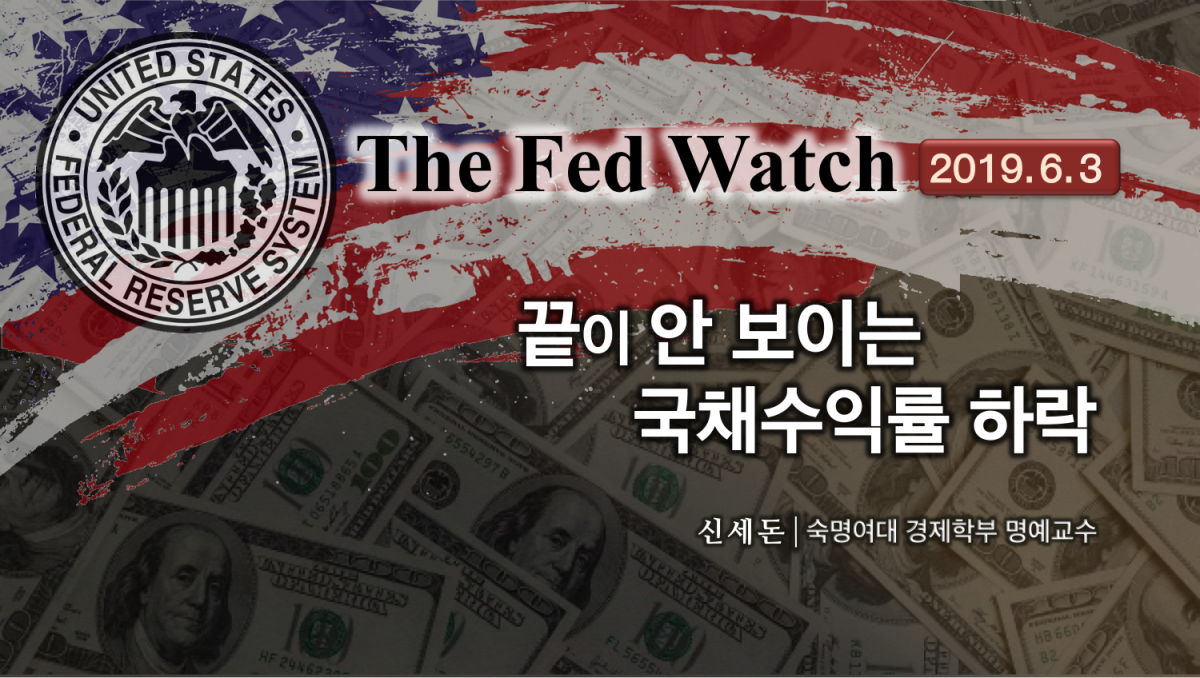국가미래연구원은 폭 넓은 주제를 깊은 통찰력으로 다룹니다
※ 여기에 실린 글은 필자 개인의 의견이며 국가미래연구원(IFS)의 공식입장과는 차이가 있을 수 있습니다.
관련링크
본문
<1> 금주의 T-Bill 수익률 곡선(Yield Curve) : 장기국채 수익률 큰 폭 하락.
■ 지난 주(5/23-5/30) 국채수익률은 그 전 주에 비해 큰 폭으로 하락
- 단기물(1월,3월,6월물)은 거의 불변이나, 중장기물은 8bp∼10bp 하락.
- 그동안 단기물 수익률 하락이 장기물에 비해 과도[이를 배뽈록이(belly)라고 부름]
한 데 따른 조정
- 5월 들어 국채수익률 하락이 5주째 진행 중.
- 이는 ① 미중 무역분쟁과 미국 및 세계 경제둔화 우려와
② 미국 주식시장하락 및 불안감 고조로 인하여 미국 국채수요가 급증한데 기인
■ 지난 주말인 5월 24일 약간의 수익률 반등조정이 있었으나 현충일 휴일 이후 지속하락. 현재 국채수익률은 거의 2017년 11월 수준으로 되돌아 감
- 5년 물 2.00% 수익률은 2017년 11월 17일 1.98% 이후 최저치
<2> 연준 부의장 클라리다의 뉴욕 경제협회 발언 중 통화정책에 관한 언급
■ 현재 연방기금금리는 장기적으로 중립적인 수준의 범위 안에 있으며
실업률은 적정 실업률보(u*)다도 매우 낮은 수준에 와 있다.
이런 수치들을 1993년 테일러 공식에 집어 넣어보면
연방기금금리가 2,25%-2.50%가 도출되는데 이것이 바로
지난 1월 이후 FOMC가 견지하고 있는 수준이다.
지난 5월 회의에서도 FOMC는 이런 정책기조가 적절하며 이것은
다소 낮은 최근의 인플레 통계가 일시적일 것이라는 판단을 반영한 것이었다.
이러한 판단은 2020년이면 PCE 물가상승률이 2%가 될 것이라는
다수 민간 예측기관과도 상응하는 것이기도 하다.
그러나 만약 앞으로 들어오는 물가통계가 지속적으로 2%에 못미친다거나
세계경제 및 금융시장 상황이 우리가 예측하는 기본 예측보다
실질적으로 더 낮은 방향으로 가는 것으로 나타난다면
이런 상황발전을 FOMC가 반영하여 적절한 통화정책 방향을 수립할 것이다.
The Federal funds rate between 2.25 and 2.5 percent, which is the range for the policy rate that the FOMC has reaffirmed since our January meeting. Most recently, the Committee judged at our May meeting that the current stance of policy remains appropriate, and that decision reflects our view that some of the softness in recent inflation data will prove to be transitory. This judgment aligns with some private-sector forecasts, which now project PCE inflation to return to 2 percent by 2020. However, if the incoming data were to show a persistent shortfall in inflation below our 2 percent objective or were it to indicate that global economic and financial developments present a material downside risk to our baseline outlook, then these are developments that the Committee would take into account in assessing the appropriate stance for monetary policy.
<3> 2019년 4월 22일 및 5월 1일에 있었던 FOMC 회의록 내용.
(*) 연준은 2019년 4월 22일과 5월 1일에 있었던 회의내용을
5월 28일 공개하였음.(원문은 부록에 첨부)
(A) 4월 22일 연준 재할인율 및 선급금이율에 대한 의결(4월 22일)
■ 12개 지역 연방은행이 요청한 primary credit rate(3%) 동결요청에 대하여
- 보스톤,클리블랜드,아틀란타,캔자스시티,댈러스샌프란시스코는 4월11일,
뉴욕, 필라델피아, 리치몬드, 시카고, 세인트루이스, 미니애폴리스는 4월18일
동결하기로 결정함에 따라
연준이사회도 primary credit rate(3%) 동결하기로 결정함(4월 22일)
(의결이유)
비록 인플레압력이 다소 완화되기는 했지만 12개 지역은행 총재들은
현재 통화정책기조를 유지하는 것이 적절하며
또한 FOMC도 견실한 경제성장, 강한 노동시장 및 2% 인플레 목표 달성과
부합되도록 정책을 유지하여야 한다고 판단되어 기존 3%를 유지하기로 결정함.
“Although inflation had softened recently, the directors judged that maintaining the current stance of monetary policy was appropriate and that the FOMC should continue to follow a patient approach in assessing whether incoming data remained consistent with the outlook for continued solid economic growth, strong labor markets, and inflation remaining near the FOMC's 2 percent objective. ”
■ 이와 함께 the secondary and seasonal credit 규정도 갱신하기로 함.
- 이차적 및 계절적 수요자금에 대한 재할인/선급금 적용금리도 갱신하기로 함
즉, 이차적/계절적 자금금리는 primary credit rate(3%)에 50bp를 가산함.
계절적 자금금리의 경우 매 2주간의
실효연방기금금리와 3개월CD 금리의 평균금리에 따라 조정될 것임.
(가장 가까운 5bp로 절삭)
■ 찬성의결 : 파월, 클라리다, 브레이나드, 바우먼)
(B) 지준예치금리 인하 조치(5월 1일)
■ 연준 및 FOMC 연석회의의 연방기금금리목표 동결결정(2019년4월30-5월1일)에
따라 연준은 2019년 5월 2일부터 연방은행에 예치된 의무지준예치금 및 초과 지준예치금에 대한 금리를 2.40%에서 2.35%로 인하하기로 결정함.
지준예치금금리를 연방기금금리목표의 상한(2.50%)보다 15bp 낮게 설정한 것은
시장 연방기금금리가 연방기금금리목표에 근접하여 운용되도록 하기 위함임.
■ 찬성의결 : 파월, 클라리다, 퀄즈, 브레이나드, 바우먼
<4> 뉴욕 연방은행 총재 John Williams (John C. Williams, 1962. 6. 12 ~ )

존 윌리엄즈는 새크라멘토에서 출생해서 1984년 UC 버클리에서 경제학사를 우등으로 졸업하고 1989년 런던경제대학(LSE)에서 경제학 석사를 마친 다음 스탠포드대학에서 1994년 경제학박사 학위를 취득했다. 학위를 마친 뒤 1994년 바로 미국연방은행 이사회(the Board of Governors of the Federal Reserve System)에서 연구원으로 입사했으며 8년 뒤인 2002년 고향인 샌프란시스코 연방은행의 이사가 되었다.
FRB 샌프란시스코 연방은행 제넛 옐런 총재(2004-2010) 밑에서 연구부장 및 부총재를 역임한 그는 2011년 3월 연준 부의장으로 옮겨 간 제넛 옐런의 후임으로 샌프란시스코 연방은행 총재로 부임했다. 2018년 4월 윌리엄 더들리의 후임으로 뉴욕연방은행 총재로 부임했다.
금융학자인 윌리엄는 The American Economic Review 의 부편집인 역할을 수행 했으며 스탠포드 대학에서 강의를 하기도 했다. 현재도 International Journal of Central Banking의 편집인으로 활동하고 있다. 부인 오드리 린든 윌리엄즈 또한 UCSF에서 가정의학교수로 재직 중에 있다. 뉴욕연방은행 총재는 FOMC의 당연직 부의장이 되므로 윌리엄즈는 FOMC의 부의장이기도 하다.
연방은행법에 따르면 연방은행 총재의 임기는 1 혹은 6으로 끝나는 해의 2월 말일에 종료되도록 되었다. 또한 65세가 되면 원칙적으로 은퇴해야만 한다. 다만 55세 이후에 총재가 된 경우에는 연준 이사회가 의결을 하면 10년 근속하거나 혹은 70세가 될 때 까지 근무할 수 있다.
[부록.2] <4월22일 및 5월 1일 회의록 원문>
■ DISCOUNT AND ADVANCE RATES -- Requests by twelve Reserve Banks to maintain the existing primary credit rate; requests to renew the secondary and seasonal credit formulas.
Today, Board members discussed economic and financial developments and issues related to possible policy actions. In connection with this discussion, Board members considered discounts and advances under the primary credit program (the primary credit rate) and discussed, on a preliminary basis, their individual assessments of the appropriate rate and its communication, which would be discussed at the joint meeting of the Board and the Federal Open Market Committee (FOMC) next week.
Subject to review and determination by the Board of Governors, the directors of the Federal Reserve Banks of Boston, Cleveland, Atlanta, Kansas City, Dallas, and San rancisco had voted on April 11, 2019, and the directors of the Federal Reserve Banksof New York, Philadelphia, Richmond, Chicago, St. Louis, and Minneapolis had voted on April 18, to establish the primary credit rate at the existing level (3 percent).
Overall, Federal Reserve Bank directors remained positive about the economic outlook and anticipated continued moderate growth. Many directors noted a pickup in economic activity, particularly since the start of the year. However, economic conditions varied across sectors and Districts. Several directors reported steady advances in manufacturing output and residential real estate activity but also observed that consumer spending had slowed recently. Directors in a number of Districts stressed that labor markets remained tight, with skilled workers in especially high demand, and some directors reported increasing wage pressures. While concerns about trade policy had abated to a certain extent, some directors cited continued uncertainties about the global economy as a potential risk to the U.S. economic outlook.
The directors of all twelve Reserve Banks favored establishing the primary credit rate at its existing level of 3 percent. Although inflation had softened recently, the directors judged that maintaining the current stance of monetary policy was appropriate and that the FOMC should continue to follow a patient approach in assessing whether incoming data remained consistent with the outlook for continued solid economic growth, strong labor markets, and inflation remaining near the FOMC's 2 percent objective. Existing rate and formulas approved.
April 22, 2019.
No sentiment was expressed by the Board at today's meeting for changing the primary credit rate at this time, and the Board approved the establishment of the primary credit rate at the existing level of 3 percent. (NOTE: At the joint Board-FOMC meeting on March 20, 2019, the Board had approved the establishment of the primary credit rate at 3 percent.)
The Board's action today on the primary credit rate also included renewal of the existing formulas for calculating the rates applicable to discounts and advances under the secondary and seasonal credit programs. As specified by the formula for the secondary credit rate, this rate would be set 50 basis points above the primary credit rate. As specified by the formula for the seasonal credit rate, this rate would be reset every two weeks as the average of the daily effective federal funds rate and the rate on three-month CDs over the previous 14 days, rounded to the nearest 5 basis points.
(Voting for: Powell, Vice Chair Clarida, and Governors Brainard and Bowman.)
■ MONETARY POLICY IMPLEMENTATION -- Decrease in the interest rate on reserve balances; rates on discounts and advances unchanged; renewal of secondary and seasonal credit formulas.
In a joint meeting of the Federal Open Market Committee (FOMC) and the Board today, the FOMC decided to maintain the target range for the federal funds rate at 2.25 to 2.50 percent. Consistent with the FOMC's decision to leave the target range for the federal funds rate unchanged, the Board approved decreasing the interest rates paid on required and excess reserve balances from 2.40 percent to 2.35 percent, effective May 2, 2019. Setting the interest rate paid on required and excess reserve balances 15 basis points below the top of the target range for the federal funds rate is intended to foster trading in the federal funds market at rates well within the FOMC's target range.
At today's meeting, the Board also approved the establishment of the interest rate on discounts and advances made under the primary credit program (the primary credit rate) at the existing level (3 percent).
Subject to review and determination by the Board of Governors, the directors of the Federal Reserve Banks of Boston, Cleveland, Atlanta, Chicago, Kansas City, Dallas, and San Francisco had voted on April 25, 2019, to establish the primary credit rate at the existing level of 3 percent.
No sentiment was expressed by the Board at today's meeting for changing the primary credit rate at this time, and the Board approved the establishment of the primary credit rate at the existing level of 3 percent. (NOTE: At the Board meeting on April 22, 2019, the Board had approved the establishment of the primary credit rate at 3 percent.)
The Board's action today on the primary credit rate also included renewal of the existing formulas for calculating the rates applicable to discounts and advances under the secondary and seasonal credit programs. As specified by the formula for the secondary credit rate, this rate would be set 50 basis points above the primary credit rate. As specified by the formula for the seasonal credit rate, this rate would be reset every two weeks as the average of the daily effective federal funds rate and the rate on three-month CDs over the previous 14 days, rounded to the nearest 5 basis points.
(Voting for : Powell, Clarida, Quarles, Brainard and Bowman.) <ifsPOST>
- 기사입력 2019년06월02일 17시05분
- 최종수정 2019년06월02일 11시22분
댓글목록
등록된 댓글이 없습니다.

